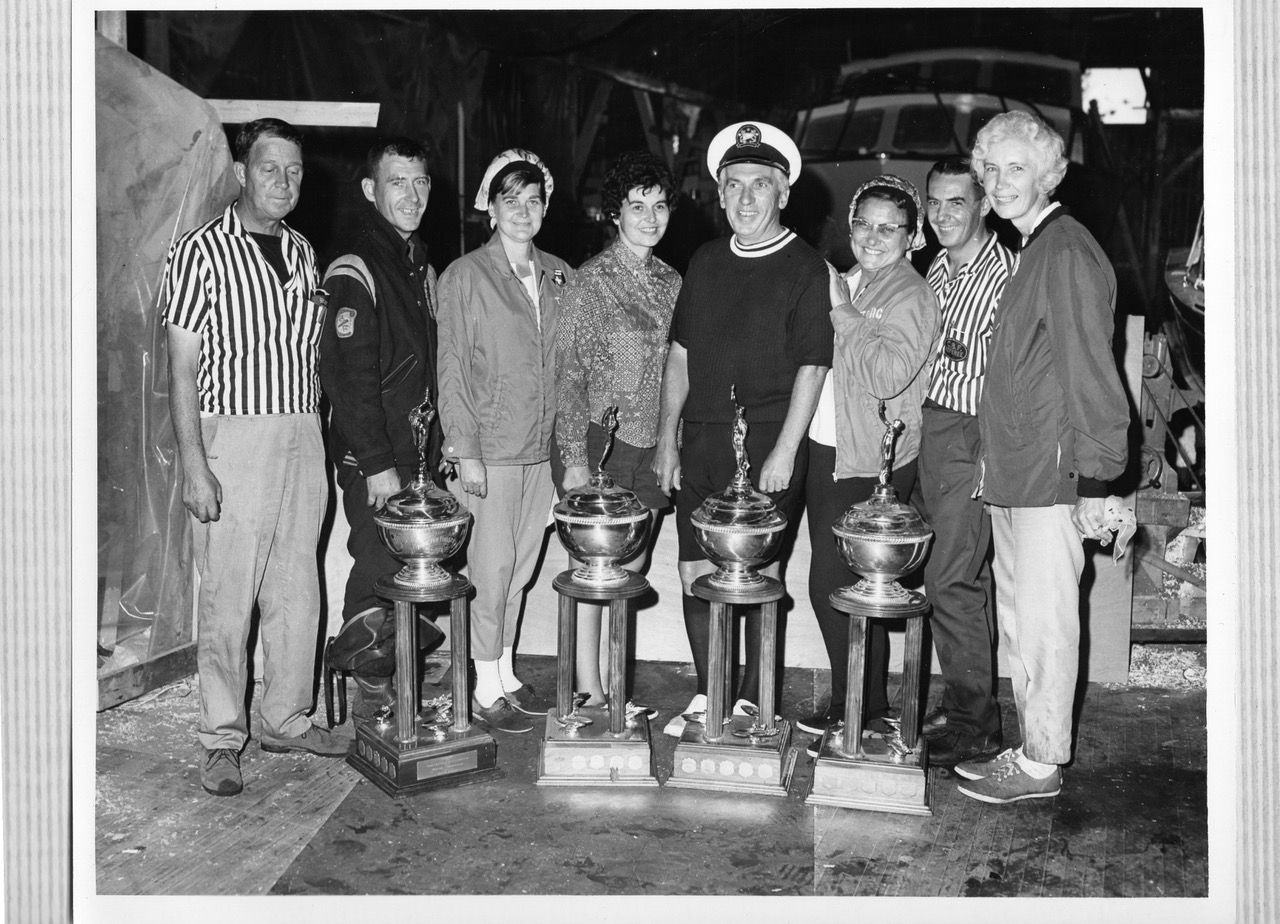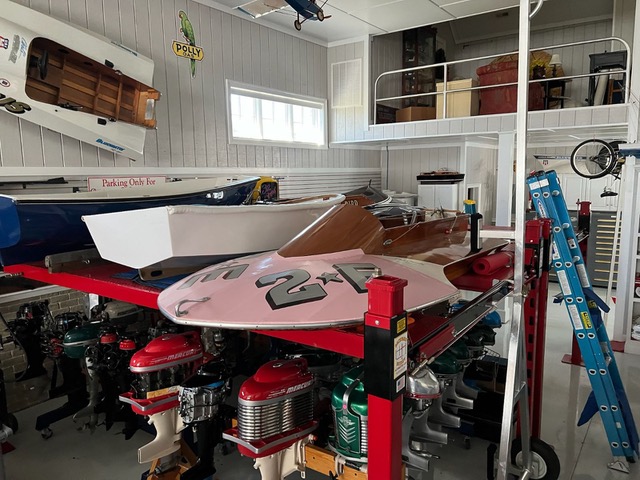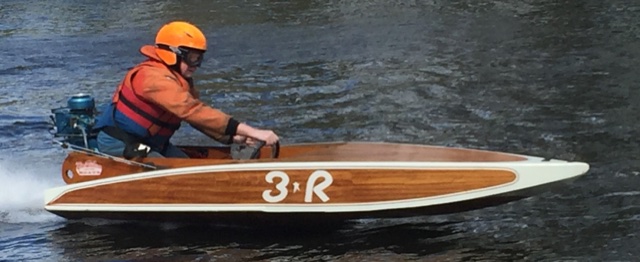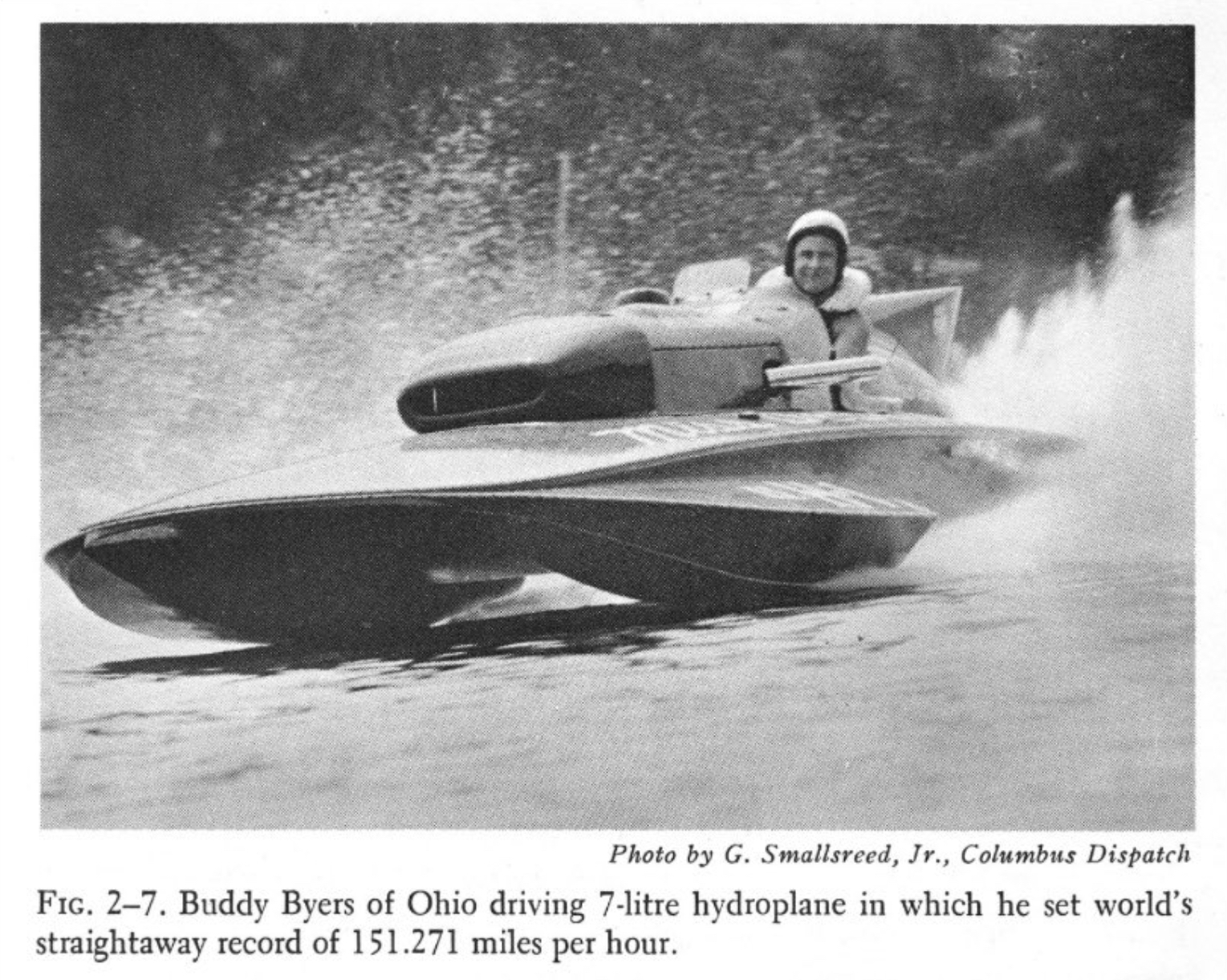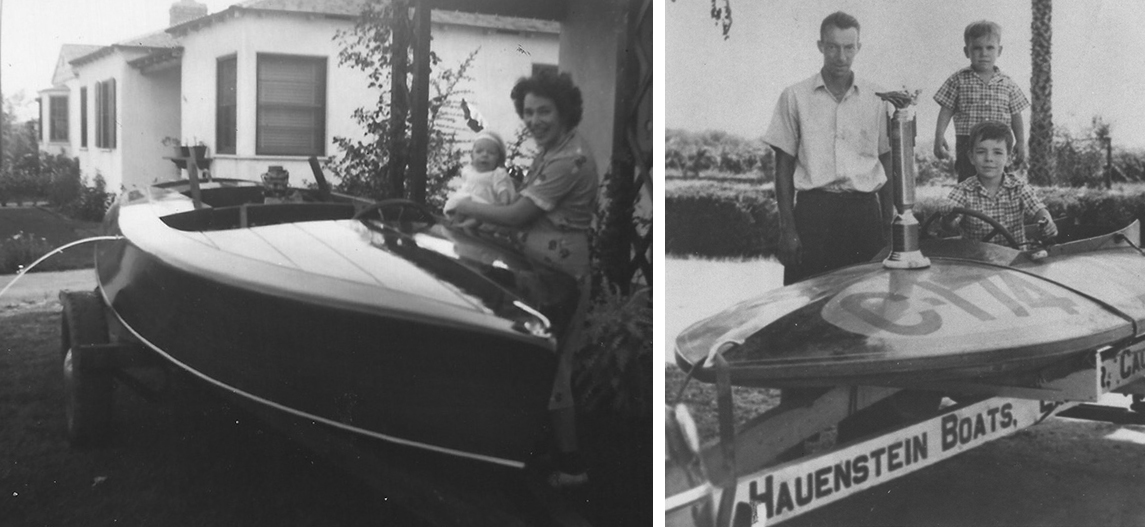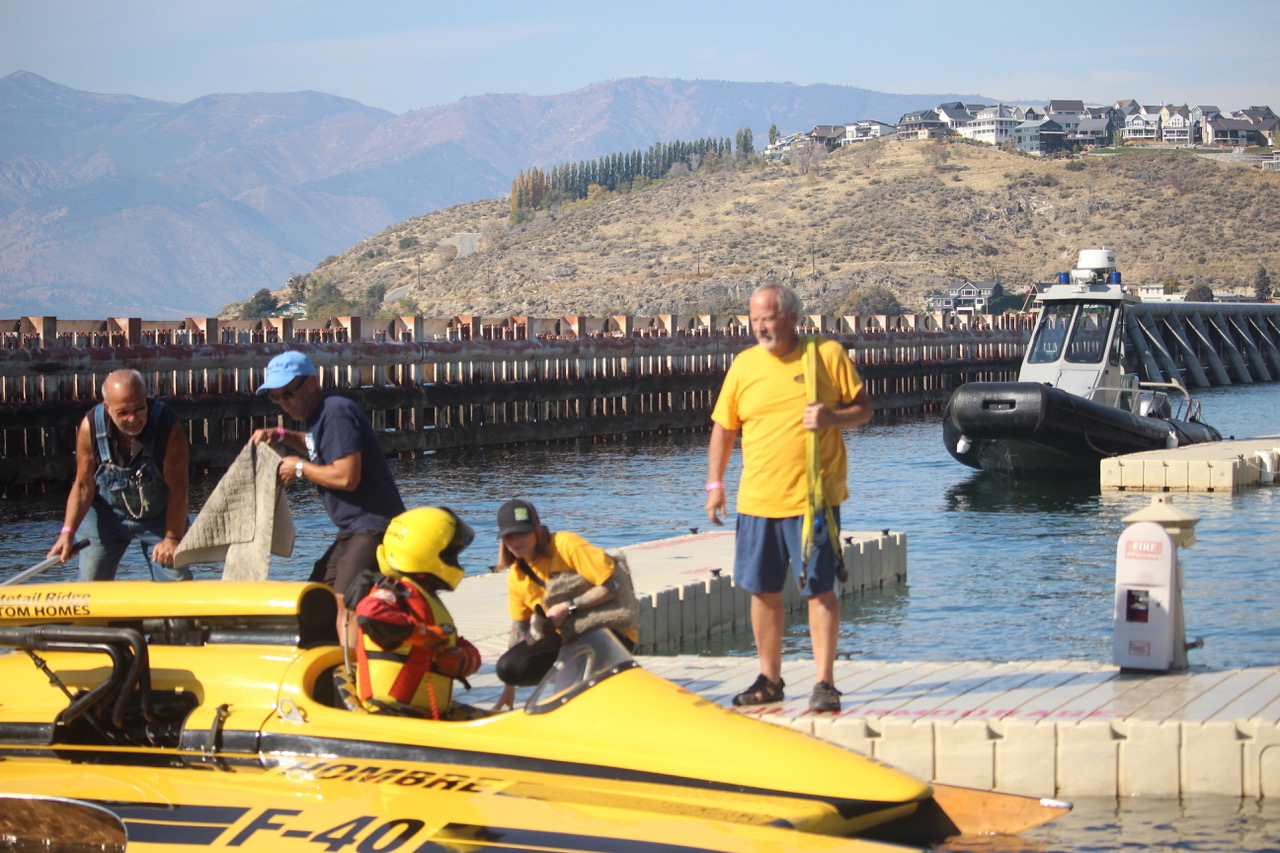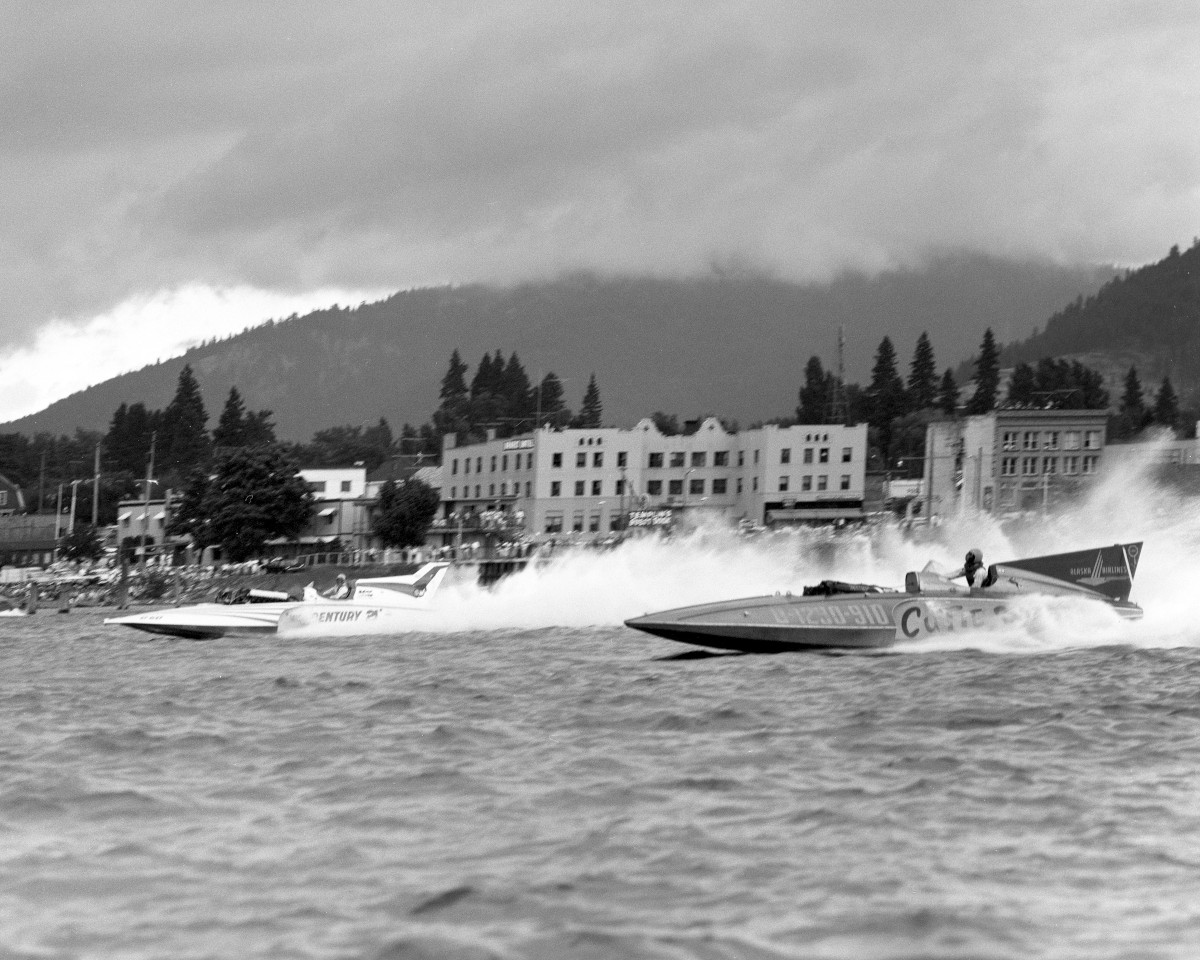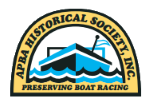An Interview with Fred Hauenstein, Jr.
November 29, 2023 - 10:28pm

(L) Mom Fran Hauenstein holding baby Fred Jr. while working on a boat in 1943. (R) Fred Sr. after he won a big race, with pit crew Fred Jr. (holding the wheel/throttle) and brother Jim.
Photos courtesy of Hauenstein family
Fred Hauenstein grew up in a racing family. He was born in Glendale, California, in 1943, and lived in Kingsburg, in the San Joaquin Valley. In 1960 he began racing outboards. He later competed in tunnel outboards. Hauenstein served two terms as President of APBA, and was inducted into the APBA Honor Squadron in 1990. He still occasionally races D Mod Hydro. The following interview was conducted by Craig Fjarlie during the 2018 Stock and Mod Outboard Nationals at Moses Lake, Washington, and updated at Lake Lawrence in September 2023.
Did you develop mechanical and racing interests when you were young?
Yup— (inspired by) my mother and father, I guess. My grandfather was an engineer. My dad wasn’t an engineer, but he was involved in boat racing before he was married. I think he started in 1939, a little before the War. He ran mostly Racing C at the beginning.
I’m the oldest; Jim was a year younger, then my little brother Donnie was born about five years after me. At that time my dad was a long-haul truck driver. He was making fairly good money but not enough to continue boat racing, so he quit for a few years. Then my folks opened a truck stop. After he got fairly comfortable there, he started racing again in 1956. He ran C Racing Runabout and C Service Runabout. That was it. I started in runabouts. That’s all I ran for the first three years.
My brother Jim and I were my dad’s pit crew. Jim and I would pick up the nose of his runabout and carry it, and he’d carry the back end—launch in the water like they did in the old days. We weren’t very old—10 to 14. We got to play around, mess with the boats and things. My dad was a Mercury dealer in 1958-60, along with the truck stop business. When I was 15 or 16, I got to go to the Mercury service school. That was pretty cool. They trusted me to handle a wrench or two (laughs). So, I started in 1960 in C Service Runabout, and soon started running a Mercury Racing C.
Were you using your dad’s second-hand equipment?
No, I was driving Henry Wagner’s boat. My dad just ran the Racing C and let Jim run the Service C stuff. We both started at the same time. I thought Henry trusted me more than Jim, but I always wondered why Jim got my dad’s stuff and I didn’t.
Soon after that you won the Col. Green Round Hill Trophy.
That was ’63, when I won the Runabout Nationals right here (in Moses Lake). That was my first Nationals win. Jim Schook had been winning a whole bunch of stuff with the Quincy Welding Works. They had tweaked the prop we had for that race. They said you had to weld a little extension on the pipes. Instead, I wrapped some aluminum on it, hose clamped it on so I could get it running for the weekend. I actually ran third in the first heat behind Jim Schook. In the second heat I ran second behind Schook and he lost a gearcase, so I was best of the rest, I guess.
That was in D Racing Runabout. The next year we went to Casper, Wyoming, for the Nationals and I won C Racing Runabout. I was second in D Runabout, behind (Rich) Fuchslin. My brother Jim won C Service Runabout both years, ‘63 and ’64.
What equipment did you run?
I ran DeSilva boats. I did most of the engine rebuilding and that sort of thing. Bought the modifications, basically, from Quincy Welding.
When I won C Runabout in Casper, we had gone to the Divisionals in Bakersfield the weekend before. I thought the engine was getting a little weak and I put fresh rings in it. Went down to Bakersfield and it ran terrible. It just wouldn’t go. So we packed everything up and went to Casper. Got the engine on the tailgate of the station wagon, ripped it apart, took it back to the hotel room and honed it with one of those flex hone things—bzzz, bzzz, bzzz. Put it back together the next morning on the tailgate of the wagon, and it ran well enough to win the Nationals (laughs). Just one of those things; I must’ve done something wrong and didn’t get it to seat.
I won both of those races with props from Quincy Welding. They were basically like Kamiks or Michigans. The D was a Michigan, the C was a little Kamik. Shortly thereafter I got acquainted with R. Allen Smith, and those were the props.
What happened then?
In 1967 Linda and I got married. Quit racing (not for long). I was at Bakersfield in March, racing with a brand new Belleville hydro and a Konig. In ‘67, I had the rotary valve Konig which wasn’t quite legal yet in the U.S., but they held the John Ward Trophy Race up in Valleyfield that year. This is a UIM trophy. Both my brothers and a couple of their friends hauled the stuff to Valleyfield and I ran the John Ward Trophy Race there. I made a little mistake, but won the second heat. Got a first and a third. Ronnie Hill had a first and a second, so he won it. The next year the John Ward Trophy Race was in DePue. So, I tested at DePue and tried to qualify. I broke a sponson on my hydro and broke the bottom. My engine wasn’t running real well either. Marcel Belleville was there to run the John Ward Trophy Race, but he jumped the gun. Norm Weiss was racing there, also. Norm didn’t qualify but he had a really good engine. So for the finals, I’ve got Marcel’s boat and I’ve got Norm’s engine. Harry Bartolomei had owned all the equipment Ronnie Hill won with the year before. He and Ronnie had had a pretty good falling out, so Harry loaned me the prop Ronnie had won with the year before. The only thing of mine in the boat, I think, was the battery, and the fuel. In the C Hydro race I came out of the first turn, going down the backstretch, and a wire came loose. It quit. I coasted clear off plane before the next boat went by me. I got it all put together and won the second heat of C Hydro. Then the John Ward race came up. In the first heat I was out in front and running hard. Coming out of the first turn the last time, it felt really stiff. I babied it down the backstretch. I backed off for the turn, and water was coming in. I thought, “Oh, I know why.” Drove around the turn, crossed the finish line and signaled for the pit crew to grab me when I came in. It had filled up. The right rear had blown out of the boat. The bottom had come loose and the water coming in had blown that thing out. So, Marcel Belleville put nails in that bottom about every inch, to get the bottom back up. There was nothing he could do about the transom piece and the fact it was filling up. Ten guys, five guys on each side, carried the boat out, held it up, waited until I started it, and then wouldn’t let me go until I made sure it was running right. Launched me, I went out and made one of the better starts I’d ever made and won the second heat. So, I came into the pits, into the inspection area, they looked at it and made sure everything was okay. All the California guys had me get back in the boat and they carried the boat over their heads, back to my pit area. That was one of my highlights—the John Ward Trophy Race.

(L) Driving 700cc Runabout in 1963 and (R) winning the APBA Colonel Green Round Hill Award for the second time in 1971. Photos courtesy of Hauenstein family
You won the Col. Green Round Hill Trophy a second time, in the early ‘70s.
Yeah, before I moved to Waukegan, before I left California.
What were you doing for employment at that time?
I was working in the Bay Area for a NASA subcontractor who ran wind tunnels. NASA had a hiring freeze so could only hire companies, not people. So, we ran three of the wind tunnels in Mountain View, California. I graduated from Cal Poly in San Luis Obispo in mechanical engineering, and went to work there for a company called ARO Incorporated. Did a master’s degree in mechanical engineering. I got involved with the Outboard Marine factory team, running a bit of their stuff off and on—Havasu, Parker… Knew all those people. Got to talking to them at the ‘73 Parker. I think they won it with the rotary engine that year. One of their engineering guys was out there with the team. I finally said, “You got any engineering jobs?” They took me up on the idea.
I broke my tunnel boat and fell out, obviously. Running along, it just flipped and I went in the water. I hurt my leg—a big, deep muscle injury. So, I was resting up, lying in the motel room, and the OMC engineer came to interview me for this job. They’d been celebrating, so he’d had a couple drinks. He’s interviewing me and I’m lying in bed. They called me the next week and invited me back for an interview in Waukegan.
I went to work at OMC in June of ’73 and worked there for five years.
I went to see Jack Leek, a really good friend, and asked about driving for him. I wasn’t pushing it. But he said, “You’re an engineer now, and too valuable to be in a race boat.” Oh, boy, I went to school to become an engineer so I could spend the rest of my life, my summers, racing boats.
It looked like it was leveling off. The last year I was there, OMC had reduced their factory team to two boats.
I was in the Johnson boat, and Jimbo (McConnell) was in the Evinrude boat. I won the Parker Enduro that year in a non-factory boat because our factory boat broke down—an accident. We went to the Nationals in late summer in Alabama. I made a great start and was out front in Mod 120, when Bill Seebold came alongside of me and blew over. My boat went straight up in the air, then the tail dropped and I was in the water. I dislocated my left shoulder, broke my right hand, and sustained a few other injuries. That’s when I was kinda, “Maybe I can do without this racing…”
After I got out of the hospital and all squared away, I went back to OMC and resigned.

Above (L) Fred driving the Parker Enduro in 1971, and (R) in 1978 as a Johnson Factory Team driver. Photos courtesy of Hauenstein family
About three days later, unknown to anybody even at Mercury, I drove up to Oshkosh and applied for a job at Mercury. I knew where to go because I’d talked to some people about it. I walked into the front office, and there was a lady taking calls, guarding the door, so to speak. I said, “I’d like to speak to Bob Johnson.” (He was in charge of all the engineering.) “Well, do you have an appointment?” “No, but I have a letter.” My right hand was in a big cast and my left shoulder was out of joint, so I hadn’t shaved for awhile. I pulled out this letter that Linda (my wife) had helped me type and handed it to her. She read it and said, “I’ll be right back,” and then she disappeared. (Oops?) She came back and said, “Mr. Johnson will see you.” I went in and talked to the boss for a while and he said, “Since you don’t work here and you’ve been working for OMC, I can’t give you a tour of the place, but we can talk about the job.” He said, “I know your qualifications, so I’ll let you know.” I drove back saying, “I wonder if I made a mistake. I hope my folks still have a job for me at the truck stop.” (Laughter.) At about 10:00 that night, Bob Johnson called me and says, “You got the job.” “Great—how soon do you need me?” He said, “Well, go easy on yourself but be here pretty soon.”
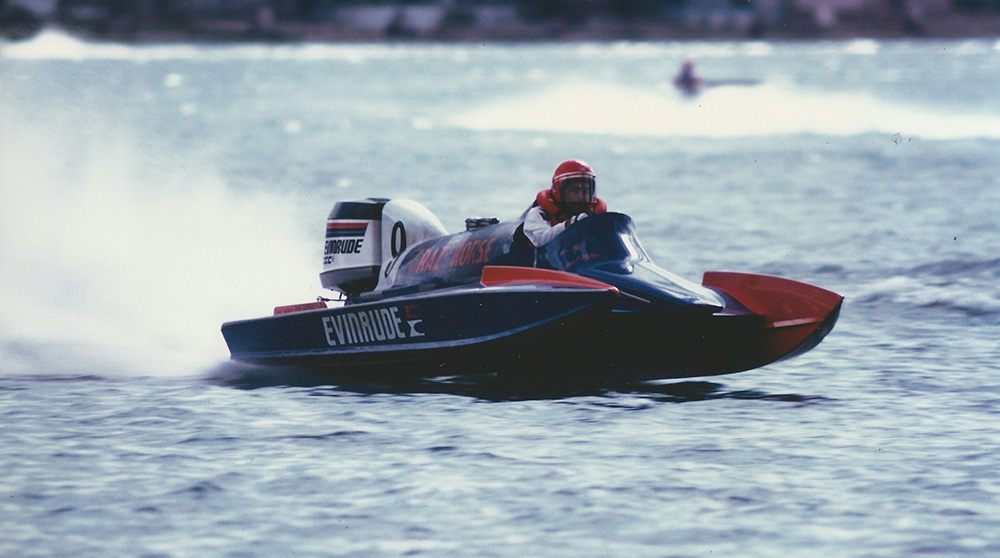
Fred winning the Parker Enduro in 1978.
So, you had to move.
Yeah, and we had just built a house in Waukegan. We lived in an apartment in Oshkosh for four years until we finally bought a lot and built a house. My wife always wondered about that, but said, “Well, Oshkosh is a better place to live and raise kids, so everything worked out well.”
When you blew over in the tunnel boat, were you racing kneeldown classes, too?
I wasn’t doing much with the outboard stuff. I still had a lot of my Konig equipment, but it was pretty well outdated. I really raced the Konigs, the Alky/PRO category, up through the mid-’70s. C and D Konig, outboard C Hydro and Runabout, and D Hydro and D Runabout, and I ran my D stuff in F Hydro and F Runabout. And actually, I had a B too. Good friend of mine named Mike Harbushka bought some B equipment and I built the B stuff for him. It’s called 350 now. Had a lot of fun with that. I won the Alky D Hydro Nationals in ‘75. Won C in ‘74. Those were while I was still working at OMC. I was still active up through ‘76, really, and got involved with the factory, driving the tunnel boats. The little stuff took a back seat for a while.
When you dislocated your shoulder and got the new job, did you stop racing for a while?
Yeah, we were traveling a lot with the factory team. We raced in the U.S. and Europe, so we were shipping engines and going over there and running stuff in Europe as well, so it slowed down my racing. I got out once a year or so. I still had a fairly good running D Hydro. Wisconsin had what they called a free-for-all, and I ran that once or twice. Some of my friends had D Stock Hydros they wanted me to drive. I drove one for Jerry Wienandt back in that era. Then I got involved in J with the kids, and I was back in it (laughs).
You kind of got out of tunnel boats for awhile.
Yeah, my brother Jim was racing the tunnel boats. He got pretty involved in it with a couple of drivers. I was never really far away from it, but I just wasn’t doing much driving. After that crash when I broke my hand and all, I kind of backed away from it. Then when they got the safety capsules, I got involved with my brother. I won the Mod 120 (they called it Champ Boat by then) Nationals at Kankakee in 1989.
We took the same boat with a little bigger engine to Parker. I was racing the Parker Enduro, running down the river. It was a three-hour race and I had an hour-and-a-half load of fuel. I was just getting light enough to where it was running at pretty much top speed. I hear a smack and the boat got high in the air, nose up—and it was all over. People said it went over twice. I actually broke my back. All my weight was caught in my shoulder harnesses. It healed without surgery, but I wore a body jacket for six or eight weeks. That pretty much ended my tunnel boat career. I didn’t need to do this any more.
Then I got back into the little kneeldown stuff.
In the 1980s, OMC had their V-8 Formula One class, and did not allow Mercurys to run with them. It was a big political argument. You and Fred Miller were arrested.
What actually happened was we called an APBA Council meeting in Chicago. At that time, the Council was 48 people or so. Mercury supported the Council to get all the people there. A lot of APBA members really believed in what we were doing. OMC was saying, “If you want to run in the series, you’re going to have to pay us a ton of money,” (like $50,000). Today that might not seem like much, but then it was a whole lot. So, we got to the meeting and the President, Stan Fitts, who I think was one of the better APBA presidents, properly said, “We choose not to recognize anybody from the floor to make a motion.” So, we were stalled. Finally, Fred Miller stood up and said, “Move to overrule the President,” and I seconded it. That passed. Then Fred made a motion that if they wouldn’t allow the Mercurys to race at Chattanooga, which was coming up soon, that APBA would refuse to sanction the race. At that time, everybody was getting ready to head for Chattanooga already. Boats were going there. We’d actually asked for an injunction in Chattanooga as well. I seconded the motion; it passed. The OMC-sided people called Chattanooga. The judge said, “Wait a minute. I have just ruled this morning that this race will go on as planned, with OMC’s rules and no Mercurys.” In other words, OMC won the battle there. He said, “I believe you guys are in contempt of court.” Mercury called. By the time this all happened I think our boats were in Chattanooga. They covered ‘em all up and got ‘em out of town really quick, before they threw a whole bunch of us in jail. So, we went to the race and watched the OMCs run around. A couple of weeks later they flew me down there because the judge wanted me and Fred in court, along with our attorney. He shouldn’t have, but he took the president of Mercury along with us. The judge worked as hard as he could to get the president to say something wrong so he could throw him in jail with us, but he didn’t. So the judge ordered Fred and me to cross the street to a holding cell. They gave us the jail clothes and all that, and we thought, “We’re screwed. Oh, man, this is not cool.” It’s a big pen, but there’s these little cells that apparently you get locked into at night. “Our attorney, who was an officer of the court, came over and said, “I can’t tell you guys what to do, but it’s a good possibility if you go across the street and apologize to the judge, he’ll turn you loose.” So Fred Miller said, “Does Dick Jordan (the president of Mercury) want us to apologize?” And I said, “Fred, if you want to stay here, that’s okay, but I’m gonna go apologize” (laughter). So, we went back and apologized, and the judge let us go. But it took about four or five hours. There were all these lawsuits between OMC and Mercury, both sides feeling that they were right.
The other thing I forgot to tell you was at the start of ‘84, I was trying to put a factory team together to challenge these V-8s. Seebold built a couple of new boats. He’d run some back in 1980 before we quit with the factory teams. Built a couple of next-generation boats that we tested, and we were developing engines. We had done pretty well with it. But the head of engineering got it in his mind that we weren’t really getting there. He came to my office in March and said, “You’re way behind, aren’t you?” And I said, “No.” I’d written a nice long two-page report to him telling him where we were in speeds, what the props were doing, the engines, gearcase stuff, the boats, and how everything was working. Somebody else had told him that I was behind. I’d broken the engines that we took down there, but how would you find out unless you get to the point where you break ‘em? I thought we were in pretty good shape. We had all the parts coming and changes that we were going to make in the next iteration, and making parts. The guy ended by saying, “The industry that I come out of, the automotive industry, gives a guy one chance to fail.” Boy, that sounded like a threat.
My really good friend Dick Snyder was in charge of High Performance at the time, and he had asked me originally, “How many boats do you think we ought to run in this team?” And I said, “Realistically, with the people I’ve got, and the budget, I think we can do one, but I have to build enough spares and we’ll get two boats. Then we can probably be okay.” Not long after that, the head of engineering (who was also Dick Snyder’s boss) had told me that I had one chance to fail. Dick told me he’d signed up a fourth driver, so we’re going to have four boats. I went to his office and said, “Dick, we can’t do four boats. Not going to be able to get it done.” Dick’s answer was, “Well, regardless, you just always seem to be able to get the job done.” I handed in my letter of resignation. I quit March 16, 1984, and went back to work in December of ‘84.
Did you work for your family?
No, I picked up a couple of consulting jobs with boat racing. We built an eight-engine offshore boat. Eight powerheads driving sterndrives for the Popeye’s team. And we built the Wizard; it was my brother’s project. My brother’s crew chief, Bill Chatfield, and I designed and built this outboard to run against the V-8s and the Mercs, but we ran a Merc anyway. We got to go to one race in London, where they followed the UIM rules, not OMC’s rules. Jim had bought a brand new boat from Burgess. We went over there and we made test laps. The thing was really smokin’ the turns. But the transom broke out of that boat before the race.
All these lawsuits were running, right up to the last race. They’d seen the Mercury T-4s run, and OMC wasn’t very worried. So, OMC said, “We can settle these. If everybody will drop all the suits, we’ll let Mercurys run at Cincinnati, the last race.” The Mercury guys asked if that included the Wizard, my brother’s project. They said, “No, no.” The Mercury guys, thank goodness, stood their ground and said, “Wizard’s going to run or no deal.” So, they let us run, settled all the lawsuits, got all the Mercurys running including our Wizard, and Johnny Sanders was driving it. It was two preliminaries and the final. Johnny won the first heat. He was leading the second heat when the transom came out of that boat. We kept telling him there’s just so much power. I think it was a combination of the power and the weight of the dang thing. At the end of the year I went back to work for a guy named Ted Morgan, who did advanced research.
Mercury dropped the racing boats. I didn’t go back to racing for a couple more years. In the meantime, with the other things I had done the first year I was at Mercury, I got really involved with the politics of UIM as well as APBA. I’ve been doing that ever since.
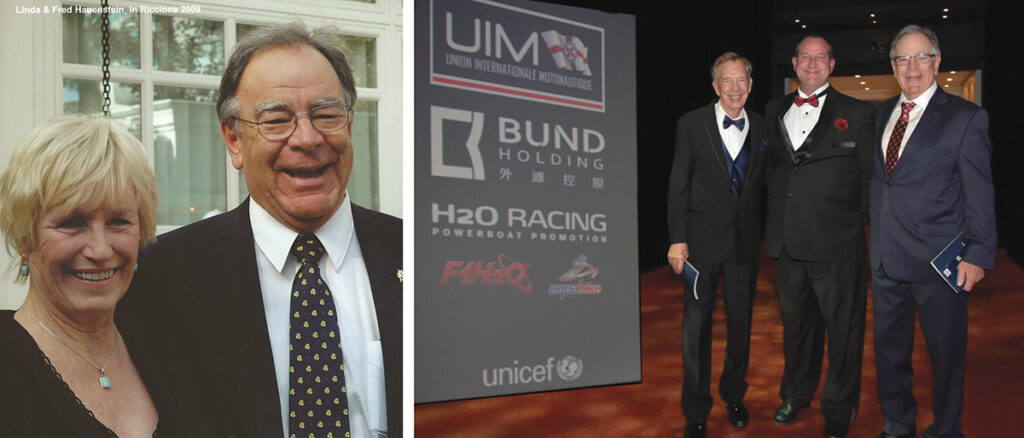
Fred and Linda (the power behind the UIM Senior Vice President) in 2017. (R) Bob Wartinger, Howie Nichols, and Fred at the 2019 UIM Gala. UIM photos.
You were involved in an incident in Monaco one year.
There was no place to park. I guess I parked in an illegal spot. I thought it was okay, but apparently the police thought otherwise. They put a boot on the car. I only realized it as I pulled out of my spot. It went clunk. Got out and looked and there was a big clamp on the front wheel. The police showed up right away. They’ve got cameras all over Monaco. It’s a police state, really—a nice police state. A few of us were involved: Mike Jones, and a good friend of ours named David Parkinson who was doing the PR stuff for Mercury Racing and was very involved in UIM as well. The policeman took the boot off the wheel, and was putting it back on. Parkinson says, “Why are you putting it back on? This is crazy.” This policeman, a big guy, stands up full height and looks down at Mr. Parkinson and says, “Sir, are you calling the police in Monaco crazy?” (Oh, no, just cuff me now.) Parkinson explained that we were there because of the prince and the boat racing and we were guests of Monaco. One of the policemen said, “Get the cuffs on, he’s Italian.” (Oooh, we just said the wrong word.) The police “taxi” showed up. It was a paddy wagon. We got in, and they locked the door, but they made me drive the car to the police station. “Follow us.” So I went to the police station. They asked for our passports. Then the policeman wanted me to take a breathalyzer test. I said, “You had me drive here.” He said, “Oh, it’s not for that, it’s just to see if you have to leave the car here overnight.” I said, “Oh, right, yeah.” I passed the breathalyzer, but it bugged me that they’d had me drive to the station. Again, Mr. Parkinson piped up: “We’ve come here many times.” I don’t know how he was saying it but he was talking about Monaco and the fact he’d visited many times for this boat racing stuff. The police said, “Yes, Mr. Parkinson, we know exactly every time you’ve come and every time you’ve left.” (Oooh!) They let us go without any fines or anything. Just lots of funny stories.
Jim got an Unlimited, built by Marcel Belleville.
Yup, Marcel built the boat. Jim ran two or three of his inboard hydros. He had a 5 Litre Stock, 280 they call it, that Marcel built. Then he and Dr. Floyd Link, a real nice older guy who was a hot-rodder down in L.A. Canyon, decided to build a 2.5 Litre Mod. Marcel built one for Jim. Floyd built this six-cylinder Datsun, ran really great. He was having a lot of fun with that. Then he decided, “Maybe I ought to build an Unlimited.” We knew what we’d done with the Wizard and the Popeye’s boat with eight powerheads in it. Had a single shaft drive, of course; can’t run an inboard hydro without a right-hand prop. It was very fast. We made a little error in setting up the drive system. We had four bulkheads; the powerheads lay on their sides, basically facing each other. Then the bulkhead the powerhead was mounted to; and another bulkhead that caught the other end of the shaft coming out of the bottom of the powerhead. We had the belts staggered, so we had one belt from one engine. These shafts coming out of the engines were typical Mercury driveshafts— 7/8 diameter with a big pulley on ‘em. Putting all that horsepower to it, with the pulley offset, pulled those shafts into each other. It just takes a little bow, but because they’re offset, it’s going to do that. So when you do that and you’ve got a belt here, you’re putting all the power through one edge of the belt and (clicks his fingers) the belt tore apart.
You did test the boat once?
Yeah, I drove it the first time we ran it at the Hydrobowl in Dayton. An amazing big boat, but the sensation of speed isn’t there with that big a boat. Bill Chatfield is from Springfield, which is near Dayton, so that was the place to go. We spent a lot of time just making it run that day, with little errors we’d made. Then we got it to run and I went up to the east end of the lake. A bass boat was there and he took off. It was the chase boat. I was coming back and I just blew by this 95-mile an hour bass boat. I thought, “Gee, I don’t know if I went 100 miles an hour, maybe 90 or something,” but apparently I was going a whole lot faster than that. So, we were deciding whether to go to San Diego, which was within about a week, I think, of that test. Finally decided, went to San Diego. The problem with the boat at the beginning was the sponsons were a little too short and with the turn fin mounted at the back of the left sponson, it was too far forward. So, when he went into the turn with power, it would keep cranking deeper and deeper into the turn, rather than going around the turn. Marcel then built the sponson back a bit, had the fin back about that much farther, and the boat would drive around the turn before he had to back off completely. So, we felt the boat was pretty doggone good. And the engines, we thought the power was there. Our problem was that at the time, the turbines were just getting started. I think they claimed that the turbines were, like, 2,700 horsepower, but we had a good 2,400 in that boat and we thought with the power that a two-stroke has, we’d be in pretty good shape. What we learned as time went by was that the turbines could dump enough fuel in to run closer to 6,000. No wonder! So that was part of the decision to quit. I still have trouble with the idea that the belt problem was just flexing the shaft. It was kind of crippled throughout that season. Then Unlimited rules changed; they mandated the F-16 canopy, which we didn’t have. Jim wasn’t pleased. He was going to have to completely rebuild the front end of the boat if not the back end, so he basically said, “That’s enough.” Still got the boat. It’s in Kingsburg. Somebody stole the transom piece off it to sell for scrap iron. The prop shafts I think are still there. The engines are long gone.
That kind of engine setup was working pretty well in the Popeye’s offshore.
Oh, yeah. They did a completely different setup on that one. The powerheads were in the center of the tunnel and this thing kind of reached over the corner of the tunnel and held the outdrives. Short-coupled driveshaft coming out of the bottom of the powerhead in a really deep-vee bearing system carrying the pulley on the outer edge. Did pretty well. They set it up with six 2.4 Mercurys and ran it over in the Bahamas in an Open class race and they won. Then they changed the capsules and got it ready to run the kilo. Eight engines in it. They ran through one way fairly well. When they went to turn it around and come back, I think they got it a little slow and the right rear dipped a bit and they got some water in the right rear engine. Of course, it blew the engine. Fuel’s blowing through, a rod’s swinging around, it breaks the fuel line. They’re pulling high pressure fuel in there, so they had flames coming out of the boat as they’re going back through the kilo. The crew in the boat doesn’t know that. They back off, and burning gasoline comes up under the capsule. They did get the record; I forgot what the number was. But that was kind of the end of that. The last time I heard about the boat, another offshore crew had taken it and were converting it to two Chevy engines. Anyway, that was kind of fun.
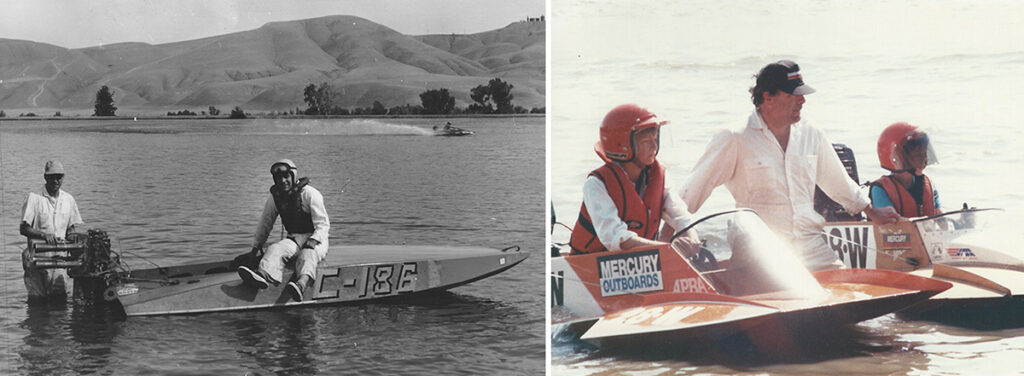
RACING GENERATIONS: (L) Fred Jr. and Pop (Fred Sr.) at Bakersfield in 1965 with CRR (500cc Runabout) and (R) Fred holding J Hydros for sons Dan (L) and Mike (R). Photos courtesy of Hauenstein family
Did you have to encourage your kids to go racing?
Not really. In ‘85 I really got started with the kids. Danny was 11, got involved with the Stock Outboards, the J program. Danny really worked his tail off; we did a ton of testing with the J in those years. Really learned a lot about it. The year that we got everything really working for Danny, he grew a bunch. Moved him forward in the boat, but kind of screwed up our setups. He was still very competitive. He grew out of the J into the A.
Mikey ran his first race when he was nine. He wasn’t really ready for it then, but he ran a few and by age 11 he was a tiger. Mikey was running the J and started killing ‘em. There were three years when he won the J Hydro and J Mod classes. He never won J Runabout. Lost one year when he was way out in front and he got the wrong flag. He, and I think, Dominic DeFebo, both pulled off the course with a lap to go in the race. “No, no, keep going, keep going,” but it was too late. He never did win J Runabout, but I think he had the speed to do it. Just didn’t get there.
During those years, were you back in the outboards?
Yes. At that time, Jerry Wienandt would loan me a D Stock engine and Sam Hemp would loan me the boat, and I’d run D Stock Hydro. I liked it. Sam brought a boat to one race and said, “Here, run this one. See how you like it; it’s a brand new boat.” By the end of that weekend I had my checkbook out and said, “Sam, how much? I want this one.” I’ve been running his big stuff ever since.
About that time, they were running the Mercury Challenge series.
Yup. When I bought the first boat I got from Sam, I got involved with that. I enjoyed that. I had a prop that would pop me on plane really quick. I went to the Nationals. I got a nice start and won the first heat. Second heat, the engine starts, it planes off, I throw the boat forward, I jump in the back and I stepped on the primer bulb. It went brbl, brbl, brbl. I ended up maybe third in that heat. I won, but, shoot…
Not out front.
Yeah, had to work in the second heat.
When you were working at Mercury, were you involved in the 44XS or the 25 engines?
Yup, did those. We actually had a guy who did a lot of the25 stuff. My group did the 44 to go with it. Basically, the same center section; gotta make sure that the area below was capable of fitting both footprints, small gearcase particularly. Just a different powerhead on top. That was a fun project. I had a good-running 55H at the time and it’s still with me. Sam Hemp had built a boat as a Mercury promo boat for the 44—something to take around and let people drive. We took that and my 55H boat, ran them side by side to make sure it wasn’t something that would just absolutely blow everybody away. You know, keep them somewhat close. Apparently people were in a buying mood, and by the time we got to the Nationals, I was probably about the only guy that had a good-running 55H in the race. Everybody else had switched over in one year. That was good. I thought that the 44 was one of those switchovers that went fairly smoothly.
It was getting harder and harder to find good parts for the 55H.
You were going to be left behind. I know the KG-4 thing brought a lot of havoc for awhile, due to a few guys who had the good KG-4 parts while most of them didn’t. Having the OMCs was a good thing.
The 55H was 40 cubic inches; the 44XS was 44. Did you have any problems getting that through the Stock Commission?
A few guys were absolutely dead set against it. Like I said, people had a lot of 55H parts, or were used to working on the 55H, and they really yelled at the time. The Stock Commission, to their credit, could see the light. At the same time Mercury was doing the Merc Challenge. Of course, that made the anti guys say, “Well, you’re buying it.” Trying to make it easy on the drivers, to make it work. There are always two sides to every story.
The 25 wasn’t as hard a sell.
Naw, I think they were ready for that one. We put a restrictor in it because they didn’t want it to go a whole lot faster than the 25SS, and yet it did. It had a lot of punch, and it was a 24 cubic inch versus 22, I think was the 25SS. The improvements we made started with the tall tower and the small skeg and went to a big skeg and a short tower. That one sold pretty easily. People liked the power that it had. At first the cowls would come apart, and we had problems with the flywheel. We broke some cranks and flywheels. But in a year or two, we got all that straight.
Did you ever drive inboards?
I ran one inboard race. At San Diego I ran both Jim’s 5 Litre and 2.5 Litre Mod. This great big Ron Jones boat was running against us. I think he had an inch or two more pitch, and he out-accelerated me. I’m thinking, “There’s something really wrong with this picture” (laughs). The 2.5 ran fairly well but it popped a plug out the side of the block. It was kind of a fun ride until that point. And then they pitched me. They’d made a rule that if you started from downtown and were making a straight, flying run to the start, you had the right of way of anybody coming around the turn to make the start. So, I’m making a nice, long run and I’m clear on the outside, had this long run at the start. Some guy coming around the turn slides in behind me and they pitched me for cutting him off. Wait a minute!
You ran against Duke Waldrop for APBA President. He was pretty involved, but right after that he faded from the scene.
Yeah, I don’t think he was happy. Duke and I were friends; we’re still friends. Linda and I were driving back from Houston after dropping Danny or Mike off at Rice University. We got a call regarding a letter OMC had sent out, promoting Duke as President. They’d written a little about us and it was pretty negative about me personally. “Well, that’s pretty small of them,” I thought. Of course, my wife has a little more temper than I have and she said, “Grrr, we gotta do something.” When I went back to work at Mercury I mentioned it to the guys there who were helping me with the campaign. They said, “Oh, yeah, we saw that,” you know, that sort of attitude. I said, “Should we write a reply or something?” They said, “Naw, we’re going to send out a nice letter; we’re not worrying about replying to this.” Well, then Duke and his campaign sent out a second letter which really attacked Mercury. So, then all my friends at Mercury said, “Got to write a reply.” I said, “Let’s write a nice, polite letter saying what I want to do. We’re not going to attack him. We’re just going to do it as a campaign letter rather than an attack.” OMC actually sent out a third letter, also kind of negative. I thought I still had some friends at OMC. I had left on fairly good terms. It was strange. I talked to Edgar (Rose) after I got elected, because he was the president I replaced. He gave me what information he had, and went over some files, and said, “I was really upset. They blew that whole campaign.” Okay, Edgar, no comment on my part” (laughs). I was really amazed at a couple letters I got from APBA members saying they appreciated the fact I’d run a clean campaign.
We did another thing. Nobody signed up to be Vice-President in that election. The next election was separate. I actually went to Duke and said, “How about if we decide to leave this alone and whoever loses the Presidency becomes the Vice-President?” I thought that was fair. Bob Schubert had helped me make that decision. But Duke said, “Well, no, I’m talking Steve David into running for Vice-President—the two of us as a ticket.” Oh, okay. Then Don Allen signed on to run against Steve David. Steve David won it, and I won against Duke. So, it kinda worked out wrong from Duke’s viewpoint, I think.
You served two terms in a row as president. What were some of the major issues you had to deal with?
One of our accomplishments (I think that was an accomplishment) was to change the way the organization was run. We were trying to reorganize APBA. We came up with the current board of directors. I think it works better. That 48-member council we had before was really ungainly. We changed the way elections were run so that we had a Vice-President in training for a couple of years. He became the President the next time. You elect the Vice-President to be the future President. We did a lot, I think, with that setup. I’m sure people can debate it one way or the other, but I thought it worked out. And then we had breakaway groups like AOF at the time, and tried to get them to come back in.
There were issues with Offshore at that time, too.
Offshore always has issues.
Another issue was the Unlimiteds trying to oust Don Jones. You cast a deciding vote.
Yeah, that was one of the problems we had. They had a guy lined up. They were going to vote Don out and vote this new guy in, all in one afternoon. The vote was tied, but ended up in favor of Don. I guess I tilted the vote. And at that point, the new guy was practicing his acceptance speech.
Oops, that’s like jumping the gun.
Yeah, and then they came up with another guy…
He didn’t last too long.
Yeah, a couple of years, or something like that. They got tired of him.
Well, you changed the structure of APBA leadership, but the election process of officers has been changed again.
Yeah, we changed it so that we did elect a Vice-President who would then have two years to become familiar with everything and then become President. It’s changed yet again because of all the lawsuits. Now the board of directors elects the President and the Vice-President. Typically, the board has been smart enough to try to carry the Vice-President into the Presidency, if it works out that way. Surprisingly, the board doesn’t change a lot from year-to-year. Makes you wonder, are not very many people interested, or what?
Do they feel they can’t get in even if they wanted to?
in my opinion, we have a lot of members in the various clubs and regions that would be good additions to the board, but for some reason they either don’t want to or just don’t feel they can. It’s really amazing how many really good members we have out there. All in all, our board’s a pretty good spread—outboarders, inboarders.
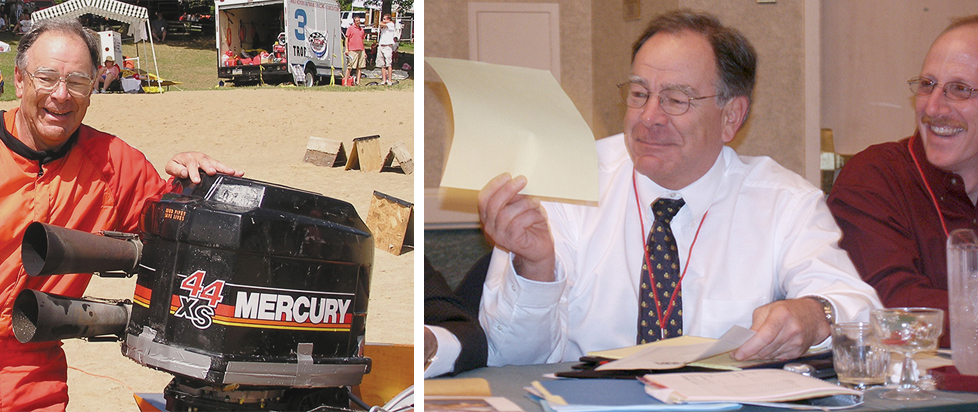
2005- Fred with his D Mod Runabout. Bob Koschka photo. (R) Keeping it light at the 2006 APBA National Meeting with Mark Weber.
You’re still on the board.
Yeah, I’m still on the board. I still enjoy that, I guess, or I wouldn’t be doing it.
I’m also the President of the Sports Commission for UIM, which is kind of a neat thing to do. We write the circuit rule book, and it puts me on the council of the UIM. I’m also an elected member of the council, which is kind of strange, but the difference is what you get to vote on. The ones who are on as Chairmen, or Presidents as they call them of the various commissions, get to vote on some things and not on others. The biggest problem with the UIM is the expense to travel to their meetings. UIM rules require that each national authority pays the members’ expenses, and APBA doesn’t do that. So, we’re on our own. I guess the bottom line is, if I enjoy it enough, then I’m willing to spend the money.
When Jim had his accident, was it hard for you to continue racing?
Strangely, I gave it little thought. There were two things that happened to Jim. The month before he died, he was in South Africa racing a tunnel boat, and it lost a sponson right at the end of the race. And somebody else had crashed. The rescue boat had gone to the other boat. Jim was upside down and he couldn’t get out of the capsule because the lid had locked into the back of the capsule. He was trapped in there and held his breath until he passed out. He woke up in the hospital. Went over and that’s sort of a normal accident in OPC, where people say, “Oh, yeah, I got wet, darn it.” Not sure if that contributed to his death a month or so later. He ruptured an aorta. I was at the Gold Cup at the time, June 1, ‘96. They were just starting the final when my mom called. Jim was in Washington, North Carolina. It’s close to Reggie Fountain’s plant, and I’d gone there several times before that, working for Mercury.
It took many years before I got out of the mode of thinking, “Gee, I gotta go home and call Jim, tell him what we just did today,” you know? Man, we spent a lot of time on the phone over the years. He was my advisor in a lot of things.
When he had the Unlimited at San Diego, Jim said, “Sometimes I think I ought to give the rest of this up, just get a D Stock Hydro and go have fun.”
Actually, the year that he died – it was when they had the Nationals in Bakersfield – we built a D Stock outfit for him. He ran it down there and we got him to run it in D Mod as well. He saw some of the same stuff running in Formula E and he said, “I’m gonna run in that, too.” He enjoyed it, but at the end of the weekend there he said, “Maybe I ought to just keep this and I’ll come up to Wisconsin and run with you,” rather than him hauling it to Kingsburg and having to find a crew to go race. But he ran in Burlington, Wisconsin, with us that year and then Bakersfield.
After he died, Danny ran the boat as a D Mod at the Nationals in Hinton, West Virginia. That was the next year, ‘97. Ran Jim’s helmet because Jim had won C-1. Kept Jim’s name on the boat. Kind of a tribute.
To wrap this up, you’ve retired. Where are you living now?
We grew up in California. We left in 1973, lived in the Midwest until 2020, and we’re permanently back in California now.
Are you still driving once in a while?
Yeah, I still enjoy it. In June, we went back ahead of the Nationals and hit Constantine. Then we flew home, left the equipment there, and flew back for the Nationals. I was going to run D Mod Hydro at the Nationals, but Danny was having problems with the boat he was going to drive, so I said, “You drive my boat and I’ll just sit the Nationals out.” It worked out okay. He’s still running the boat I would have run—the old boat instead of the new one.
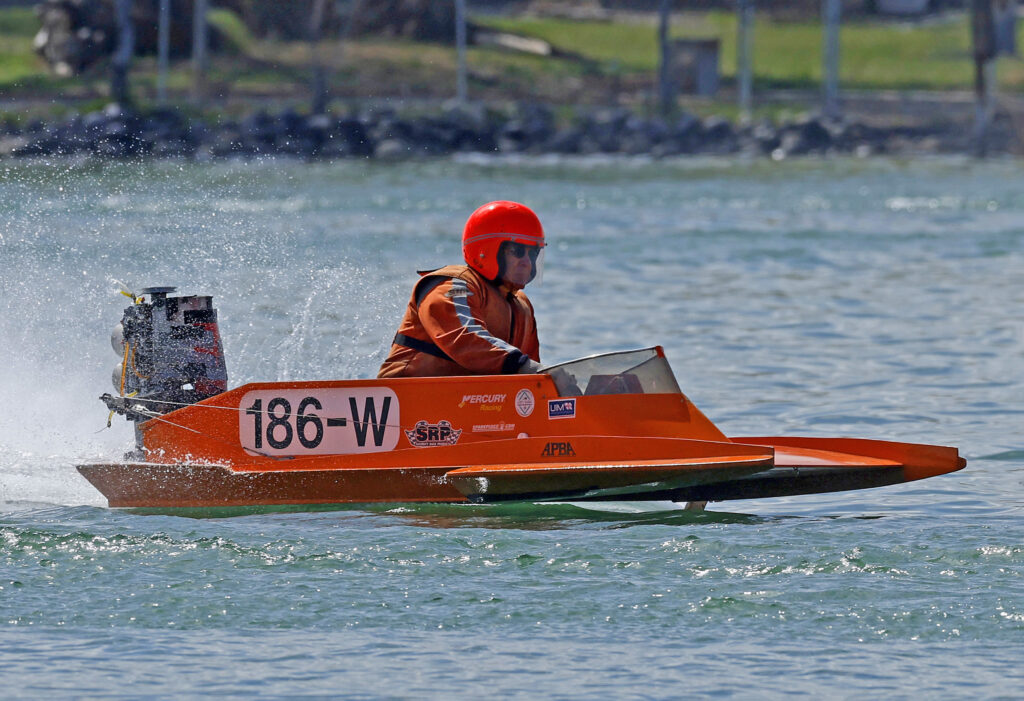
And he’s still at it! Fred racing at Moses Lake, Washington in 2023.
Gleason Racing Photography.
When you take a long view of boat racing, APBA, how do you feel about it? People have commented there’s a lot of grey hair in the pits.
Yeah, we’ve got a lot to compete against that didn’t exist 30, 40 years ago. There’s a whole raft of kids right here in this group from Washington, but their parents were involved. They’re third generation. He (points to his son, Dan) is third generation, too. We’re not really reaching out enough. I guess we have to compete against all the digital stuff that’s out there now.
All the video games and all the professional sports that are marketed so heavily.
And they’re damn good at it, pardon my language.
Even Formula 1 is attracting people. They’re doing a good job of marketing.
Yeah, that’s where we are. We haven’t really got enough finances, I believe, to do that level of marketing. You could say we are the equivalent of Go-Kart racing. Where would one of our kids go in boat racing? Maybe two or three could drive Unlimiteds. For the future, that’s about it.
They’ve attracted some new, younger drivers this year, but there are no open seats left.
Yeah, exactly.
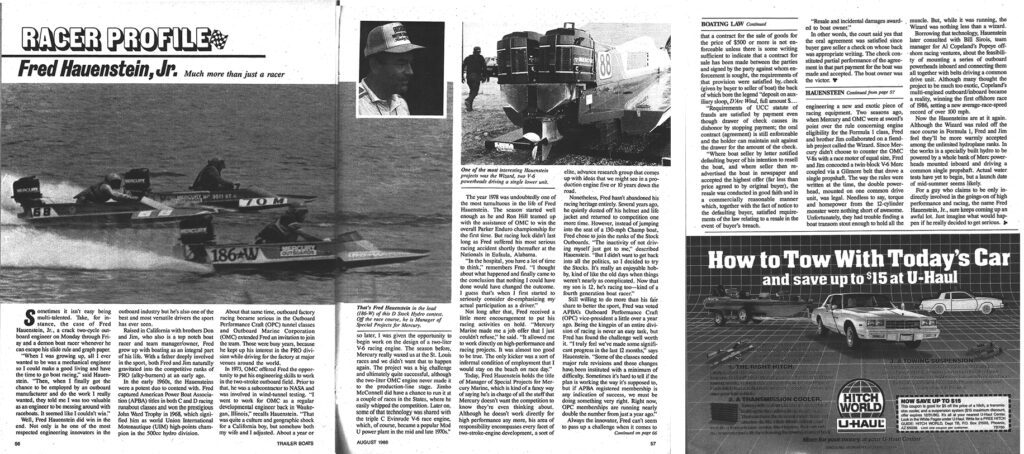
A 1986 Trailer Boat magazine Racer Profile of Fred.
Featured Articles

